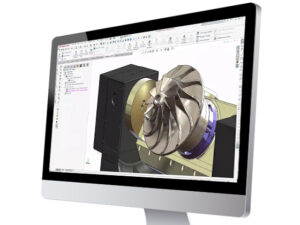I often see people using screenshots or renderings of their SOLIDWORKS models in PowerPoint presentations, but did you know that you can actually show the 3D model in PowerPoint as a 3D model that rotates in 3D? You can, and once you know the technique, it’s really easy!
SOLIDWORKS can export to many other 3D file formats, and two of them work in PowerPoint: 3MF, typically used in 3D printing, and GLB, typically used in VR/AR applications. Either format works, but they have their own benefits and drawbacks, as well:
- 3MF offers better color and material accuracy, is a smaller file size, and can be read in all Microsoft products; however, you cannot have an exploded view export to 3MF, and the files are Z-up. Generally, I use the 3MF format when exporting for Powerpoint. I like to create a Z-up coordinate system in the file and use it when exporting, so that the resulting 3MF file is oriented the way it is in SOLIDWORKS.
- GLB files are Y-up, and will allow an exploded view to come through the export process, but they are larger files and not always readable in Microsoft products. I only use this format if I want to export an exploded model into PowerPoint. Be sure to disable Draco Compression when exporting this format, otherwise PowerPoint won’t be able to read it.
Once you export the 3D model, you can drag it onto a PowerPoint slide, and by clicking on the object, you’ll see a control that will let you rotate the model into any orientation you wish! By using slide duplication and the Morph transition, you can set up true 3D rotation sequences in your side presentation. But rather than write a bunch more words and take a bunch of screenshots, I decided to make a video showing the entire process, from start to finish – using Christmas models I did in XDesign and SOLIDWORKS, of course! Enjoy the video, and happy holidays from all of us at GSC!
Share
Meet the Author

